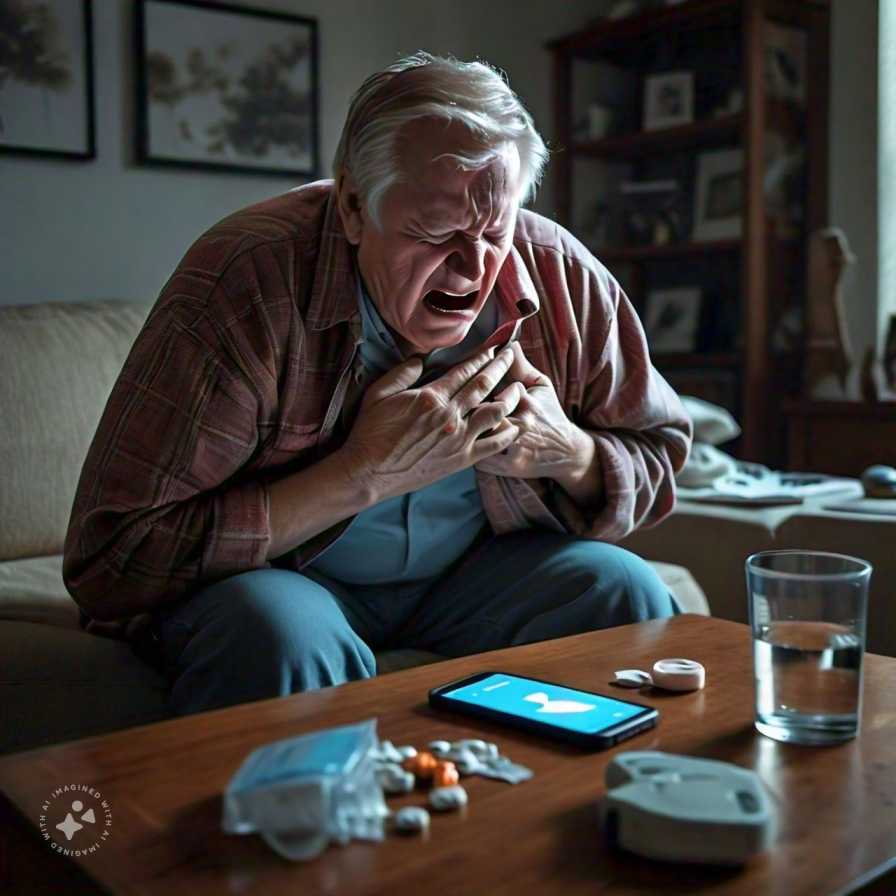Understanding Heart Attacks: An Overview
A heart attack, also known as a myocardial infarction, occurs when the blood flow to a part of the heart muscle is blocked. This blockage usually happens due to a buildup of fatty deposits called plaque in the coronary arteries, which supply oxygen-rich blood to the heart. When these arteries become narrowed or completely blocked, the heart muscle doesn’t receive enough oxygen and nutrients, leading to damage or death of the heart tissue.
1. Causes of Heart Attacks: Risk Factors and Triggers
Several factors increase the risk of having a heart attack. These include:
- High Blood Pressure: It forces the heart to work harder, increasing the risk of damage to arteries.
- High Cholesterol: Excess cholesterol can form plaque in arteries, narrowing them.
- Smoking: Tobacco smoke damages blood vessels and can cause blood clots.
- Diabetes: Increases the risk of heart disease due to high blood sugar levels.
- Family History: Genetics can play a role in heart attack risk.
- Obesity and Lack of Physical Activity: Both can contribute to conditions that increase heart attack risk.

2. Symptoms of a Heart Attack: Recognizing the Signs
The symptoms of a heart attack can vary but commonly include:
- Chest Pain or Discomfort: Often described as pressure, squeezing, fullness, or pain in the center of the chest.
- Pain in Other Parts of the Body: Pain or discomfort in one or both arms, the back, neck, jaw, or stomach.
- Shortness of Breath: Often accompanies chest discomfort.
- Cold Sweat, Nausea, or Lightheadedness: These symptoms can also occur.
Recognizing these symptoms and seeking prompt medical help is crucial as early intervention can save lives.
3. Immediate Actions During a Heart Attack: What to Do
If someone experiences symptoms of a heart attack:
- Call Emergency Services: Dial emergency services immediately for medical assistance.
- Chew or Take Aspirin: If recommended by a healthcare provider, chewing aspirin can help thin the blood and reduce heart damage.
- Stay Calm and Rest: Keep the person calm and have them rest while awaiting emergency help.
Prompt medical treatment can minimize heart damage and improve outcomes.

4. Diagnosis of a Heart Attack: Tests and Procedures
Doctors use several tests and procedures to diagnose a heart attack, including:
- Electrocardiogram (ECG or EKG): Records the heart’s electrical activity.
- Blood Tests: Measure levels of enzymes released into the bloodstream during a heart attack.
- Coronary Angiography: Uses dye and X-rays to view the inside of coronary arteries.
- Echocardiogram: Uses sound waves to create images of the heart.
These tests help determine the extent of heart damage and guide treatment decisions.
5. Treatment Options for Heart Attacks: Medical Interventions
Treatment for a heart attack aims to restore blood flow to the heart muscle quickly and prevent further damage. Common treatments include:
- Medications: Aspirin, clot-busting drugs, and medications to reduce heart workload.
- Angioplasty and Stenting: Opens blocked arteries and places a stent to keep them open.
- Coronary Artery Bypass Surgery: Creates new routes for blood flow around blocked arteries.
The choice of treatment depends on the severity of the heart attack and the patient’s overall health.
6. Preventing Heart Attacks: Lifestyle Changes and Strategies
Reducing the risk of heart attacks involves:
- Healthy Diet: Low in saturated fats, cholesterol, and sodium.
- Regular Exercise: Aim for at least 150 minutes of moderate-intensity exercise per week.
- Quitting Smoking: Avoid tobacco and limit exposure to secondhand smoke.
- Managing Stress: Techniques like meditation or yoga can help.
- Controlling Medical Conditions: Manage blood pressure, cholesterol, and diabetes.
Making these lifestyle changes can significantly reduce the risk of heart disease and heart attacks.
7. Recovery After a Heart Attack: Rehabilitation and Follow-Up Care
After a heart attack, recovery involves:
- Cardiac Rehabilitation: Exercise, education, and counseling to improve heart health.
- Medication Adherence: Taking prescribed medications as directed.
- Follow-Up Care: Regular check-ups with healthcare providers to monitor heart health.
- Emotional Support: Addressing anxiety, depression, or stress related to the heart attack.
Recovery varies for each person, and following a comprehensive care plan is essential for long-term health.

8. Complications of Heart Attacks: Long-Term Effects
Complications of a heart attack can include:
- Heart Failure: Reduced ability of the heart to pump effectively.
- Arrhythmias: Irregular heartbeats that can be life-threatening.
- Cardiac Arrest: Sudden loss of heart function.
- Stroke: Blood clot or plaque blockage in arteries supplying the brain.
- Depression: Emotional challenges following a heart attack.
Early detection, treatment, and ongoing care can help manage and prevent complications.
9. Healthy Heart Habits: Tips for Heart Attack Prevention
Maintaining heart health involves:
- Eating a Balanced Diet: Rich in fruits, vegetables, whole grains, and lean proteins.
- Staying Active: Regular physical activity to strengthen the heart and improve circulation.
- Maintaining a Healthy Weight: Achieve and maintain a healthy weight to reduce strain on the heart.
- Limiting Alcohol: Drinking in moderation, if at all.
- Getting Enough Sleep: Aim for 7-9 hours of quality sleep each night.
Adopting these habits promotes heart health and reduces the risk of heart attacks.
10. Support for Heart Attack Patients: Emotional and Mental Health
Emotional and mental health support after a heart attack involves:
- Education and Counseling: Understanding the emotional impact and coping strategies.
- Peer Support Groups: Connecting with others who have experienced similar challenges.
- Family and Social Support: Having a strong support network can aid recovery.
- Stress Management: Techniques like relaxation exercises or mindfulness.
Addressing emotional health is essential for overall well-being and recovery.
11. Research and Innovations in Heart Attack Treatment: Advancements
Ongoing research and innovations in heart attack treatment include:
- Advances in Medications: New drugs to improve heart function and prevent complications.
- Technological Innovations: Improved stents, devices for monitoring heart health, and minimally invasive procedures.
- Genetic Research: Understanding genetic factors influencing heart disease risk.
- Regenerative Medicine: Using stem cells to repair damaged heart tissue.
FAQs About Heart Attacks
1. What is a heart attack?
A heart attack, or myocardial infarction, occurs when blood flow to a part of the heart is blocked for a long enough time that part of the heart muscle is damaged or dies. This blockage is most often caused by a buildup of fat, cholesterol, and other substances, which form a plaque in the coronary arteries.
2. What are the common symptoms of a heart attack?
Common symptoms include:
- Chest pain or discomfort that may feel like pressure, squeezing, or fullness.
- Pain or discomfort in one or both arms, the back, neck, jaw, or stomach.
- Shortness of breath.
- Cold sweat, nausea, or lightheadedness.
3. What causes a heart attack?
The primary cause is coronary artery disease (CAD). CAD is a condition in which the coronary arteries become narrowed or blocked due to the buildup of plaque. Other factors include a spasm of a coronary artery, which can stop blood flow to part of the heart muscle.
4. Who is at risk for a heart attack?
Risk factors include:
- Age (men over 45 and women over 55)
- Tobacco use
- High blood pressure
- High cholesterol or triglyceride levels
- Diabetes
- Family history of heart attack
- Lack of physical activity
- Obesity
- Stress
- Illegal drug use, particularly cocaine or amphetamines
5. How is a heart attack diagnosed?
A heart attack is diagnosed through:
- Electrocardiogram (ECG or EKG)
- Blood tests to measure heart enzymes
- Imaging tests like chest X-ray, echocardiogram, or coronary angiography
6. What should I do if I suspect someone is having a heart attack?
Call emergency services immediately. While waiting for emergency help:
- Have the person sit down, rest, and try to keep calm.
- Loosen any tight clothing.
- If the person is unconscious and unresponsive, begin CPR.
7. How is a heart attack treated?
Treatment can include:
- Medications (e.g., aspirin, thrombolytics, antiplatelet agents)
- Procedures like angioplasty and stent placement or coronary artery bypass surgery
- Lifestyle changes (e.g., quitting smoking, healthy diet, regular exercise)
- Cardiac rehabilitation programs
8. Can heart attacks be prevented?
Preventive measures include:
- Eating a heart-healthy diet
- Regular physical activity
- Maintaining a healthy weight
- Quitting smoking
- Managing stress
- Regular health check-ups and managing health conditions such as high blood pressure, diabetes, and high cholesterol
9. What are the long-term effects of a heart attack?
The effects can vary but may include heart failure, irregular heartbeats (arrhythmias), and increased risk of another heart attack. Long-term treatment and lifestyle changes are crucial for managing health after a heart attack.
10. Is it possible to fully recover from a heart attack?
Many people recover fully and return to their normal activities, but it depends on the severity of the heart attack and how quickly treatment was administered. Ongoing medical care and lifestyle changes are important for recovery and prevention of future heart issues.

